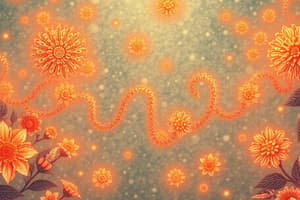Podcast
Questions and Answers
If a scientist discovers a new organism that thrives in an oxygen-depleted environment and produces ethanol as its primary metabolic byproduct, which of the following bioenergetic pathways is MOST likely being utilized by this organism?
If a scientist discovers a new organism that thrives in an oxygen-depleted environment and produces ethanol as its primary metabolic byproduct, which of the following bioenergetic pathways is MOST likely being utilized by this organism?
- Chemiosmosis driven by ATP synthase
- Anaerobic respiration via glycolysis and fermentation (correct)
- Aerobic respiration via the electron transport chain
- Photosynthesis with carbon fixation via the Calvin cycle
In a hypothetical scenario where the inner mitochondrial membrane is freely permeable to protons ($H^+$), what would be the MOST likely direct consequence on cellular ATP production?
In a hypothetical scenario where the inner mitochondrial membrane is freely permeable to protons ($H^+$), what would be the MOST likely direct consequence on cellular ATP production?
- ATP production would increase due to enhanced proton flow.
- ATP production would remain unaffected as ATP synthase is independent of the proton gradient.
- ATP production would decrease significantly due to disruption of the proton gradient. (correct)
- ATP production would cease entirely as the electron transport chain shuts down.
Which of the following scenarios would MOST directly inhibit the Calvin cycle in photosynthetic organisms?
Which of the following scenarios would MOST directly inhibit the Calvin cycle in photosynthetic organisms?
- An increase in the concentration of oxygen within the chloroplast stroma
- Accumulation of pyruvate within the cytoplasm
- A mutation that prevents the regeneration of RuBP (correct)
- Increased production of ATP and NADPH in the light-dependent reactions
If a researcher discovers a novel enzyme that significantly enhances the efficiency of substrate-level phosphorylation in glycolysis, what is the MOST likely direct outcome?
If a researcher discovers a novel enzyme that significantly enhances the efficiency of substrate-level phosphorylation in glycolysis, what is the MOST likely direct outcome?
In the context of bioenergetics, what is the MOST critical role of FADH₂ in cellular respiration?
In the context of bioenergetics, what is the MOST critical role of FADH₂ in cellular respiration?
Which of the following scenarios would have a MOST significant impact on the overall ATP yield from aerobic respiration?
Which of the following scenarios would have a MOST significant impact on the overall ATP yield from aerobic respiration?
What is a key distinction between energy production in anaerobic versus aerobic respiration that MOST directly impacts the amount of ATP generated?
What is a key distinction between energy production in anaerobic versus aerobic respiration that MOST directly impacts the amount of ATP generated?
How would a drug that inhibits the regeneration of $NAD^+$ in cells MOST directly affect energy production pathways?
How would a drug that inhibits the regeneration of $NAD^+$ in cells MOST directly affect energy production pathways?
Under conditions of intense exercise, if the rate of glycolysis exceeds the capacity of the Krebs cycle, what metabolic shift is MOST likely to occur in muscle cells?
Under conditions of intense exercise, if the rate of glycolysis exceeds the capacity of the Krebs cycle, what metabolic shift is MOST likely to occur in muscle cells?
If a plant species evolved to have thylakoid membranes with increased surface area, what direct effect would this MOST likely have on photosynthesis?
If a plant species evolved to have thylakoid membranes with increased surface area, what direct effect would this MOST likely have on photosynthesis?
How does the inhibition of RuBisCO, the enzyme responsible for carbon fixation, MOST directly affect plant metabolism?
How does the inhibition of RuBisCO, the enzyme responsible for carbon fixation, MOST directly affect plant metabolism?
What is the MOST likely effect of a mutation that impairs the function of ATP synthase in mitochondria?
What is the MOST likely effect of a mutation that impairs the function of ATP synthase in mitochondria?
In ecosystems, energy transfer between trophic levels is approximately 10% efficient. Where does the remaining 90% of the energy MOSTLY go?
In ecosystems, energy transfer between trophic levels is approximately 10% efficient. Where does the remaining 90% of the energy MOSTLY go?
How would a drug that acts as an uncoupling agent, increasing the permeability of the inner mitochondrial membrane to protons, MOST directly affect cellular metabolism?
How would a drug that acts as an uncoupling agent, increasing the permeability of the inner mitochondrial membrane to protons, MOST directly affect cellular metabolism?
Which metabolic adaptation would be MOST beneficial for an organism living in an environment with limited access to both oxygen and sunlight?
Which metabolic adaptation would be MOST beneficial for an organism living in an environment with limited access to both oxygen and sunlight?
Flashcards
Bioenergetics
Bioenergetics
The study of how energy flows through living systems, essential for processes like growth and homeostasis.
First Law of Thermodynamics (in Biology)
First Law of Thermodynamics (in Biology)
Energy cannot be created or destroyed, only transformed from one form to another.
Second Law of Thermodynamics (in Biology)
Second Law of Thermodynamics (in Biology)
Energy transfer increases entropy (disorder) in a system.
ATP (Adenosine Triphosphate)
ATP (Adenosine Triphosphate)
Signup and view all the flashcards
Metabolism
Metabolism
Signup and view all the flashcards
Cellular Respiration
Cellular Respiration
Signup and view all the flashcards
Glycolysis
Glycolysis
Signup and view all the flashcards
Krebs Cycle
Krebs Cycle
Signup and view all the flashcards
Electron Transport Chain (ETC)
Electron Transport Chain (ETC)
Signup and view all the flashcards
Photosynthesis
Photosynthesis
Signup and view all the flashcards
Light Reactions
Light Reactions
Signup and view all the flashcards
Calvin Cycle
Calvin Cycle
Signup and view all the flashcards
Enzymes in Energy Metabolism
Enzymes in Energy Metabolism
Signup and view all the flashcards
Anaerobic Respiration
Anaerobic Respiration
Signup and view all the flashcards
ATP Synthase Mechanism
ATP Synthase Mechanism
Signup and view all the flashcards
Study Notes
- Bioenergetics studies energy flow through living systems.
- It is vital for growth, movement, repair, and homeostasis.
Key Concepts
- Energy in biological systems is governed by thermodynamics.
- Cells require energy for metabolism, transport, and signaling.
Thermodynamics in Biology
- First Law of Thermodynamics: Energy is neither created nor destroyed, only transformed.
- Second Law of Thermodynamics: Energy transfer increases entropy (disorder).
Sources of Biological Energy
- Chemical energy is derived from food molecules like glucose.
- Light energy is utilized in photosynthesis.
- Mechanical energy powers muscle contraction.
ATP – The Energy Currency
- ATP (Adenosine Triphosphate) powers cellular activities.
- ATP is hydrolyzed into ADP + Pi, which releases energy.
Structure of ATP
- ATP consists of:
- Adenine (a nitrogenous base)
- Ribose (a sugar molecule)
- Three phosphate groups
Metabolism
- Metabolism includes all chemical reactions in an organism.
- It encompasses:
- Catabolism: The breakdown of molecules to release energy.
- Anabolism: The synthesis of molecules using energy.
Cellular Respiration Overview
- Cellular respiration converts glucose into ATP using oxygen.
- It includes glycolysis, the Krebs cycle, and the electron transport chain.
Glycolysis
- Glycolysis occurs in the cytoplasm.
- It breaks down glucose into pyruvate, producing 2 ATP and NADH.
Krebs Cycle
- The Krebs cycle occurs in the mitochondrial matrix.
- It produces ATP, NADH, and FADH₂ by oxidizing acetyl-CoA.
Electron Transport Chain (ETC)
- The ETC is located in the inner mitochondrial membrane.
- It uses NADH and FADH₂ to produce ATP through oxidative phosphorylation.
Photosynthesis
- Photosynthesis occurs in chloroplasts of plants and algae.
- It converts light energy into chemical energy stored as glucose.
Light Reactions
- Light reactions capture light energy in thylakoid membranes.
- They produce ATP and NADPH for the Calvin Cycle.
Calvin Cycle
- The Calvin Cycle consists of light-independent reactions in the chloroplast stroma.
- It fixes CO₂ into glucose using ATP and NADPH.
Energy Efficiency
- Energy transfer in ecosystems is not 100% efficient.
- Only about 10% of energy is passed to the next trophic level.
Enzymes in Energy Metabolism
- Enzymes catalyze reactions to lower activation energy.
- Examples include ATP synthase and RuBisCO.
Anaerobic Respiration
- Anaerobic respiration occurs without oxygen.
- It produces 2 ATP via glycolysis and fermentation (e.g., lactic acid fermentation).
Energy in Exercise
- Aerobic exercise relies on oxygen for sustained ATP production.
- Anaerobic exercise leads to lactic acid buildup and fatigue.
Mitochondrial Function
- Mitochondria are the power-house of the cell.
- They are the site of aerobic respiration and ATP production.
Disorders of Bioenergetics
- Mitochondrial diseases affect energy production.
- Diabetes disrupts glucose metabolism and energy balance.
Energy Balancing in Humans
- Caloric intake must match energy expenditure.
- Imbalances can lead to obesity or malnutrition.
Energy Storage in Plants
- Plants store energy as starch.
- Seeds and tubers are rich in stored energy.
ATP Synthase Mechanism
- ATP Synthase is located in mitochondria and chloroplasts.
- It produces ATP by utilizing a proton gradient.
Summary
- Bioenergetics explores how living organisms produce, store, and use energy.
- It is central to life, sustainability, and medical advancements.
Fun Facts
- The human brain consumes about 20% of the body’s energy.
- Chlorophyll makes plants green by reflecting green light.
Studying That Suits You
Use AI to generate personalized quizzes and flashcards to suit your learning preferences.



